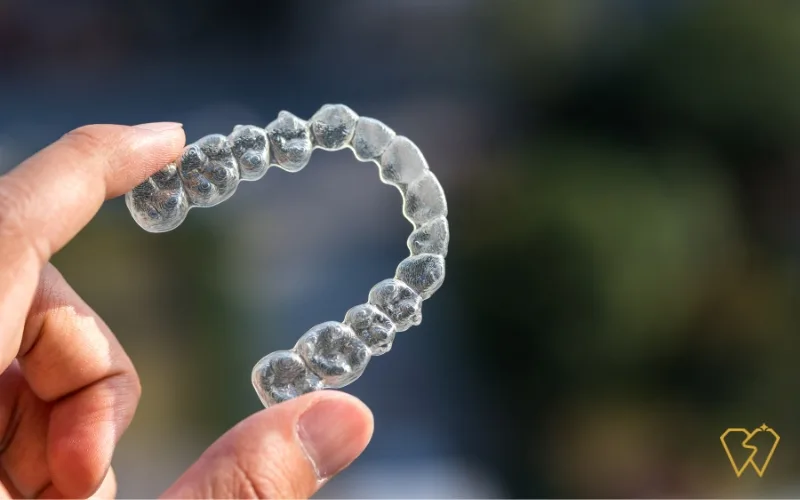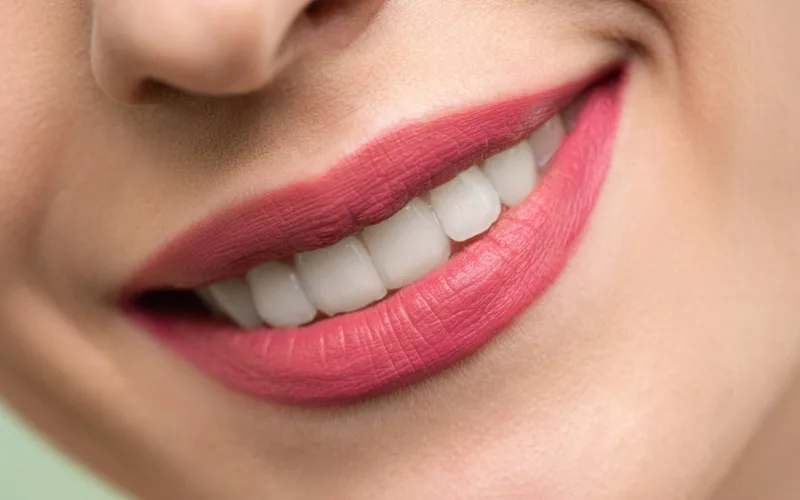Teeth whitening is the process of removing stains and discoloration from teeth. Teeth can become stained and discolored from many different things, including foods, drinks, smoking, aging, and certain medications. In this article, you will know 5 types of teeth whitening treatments that can help improve the appearance of your smile and boost your self-confidence. We will discuss each method with its pros and cons.
1. Whitening strips

Whitening strips are another popular over-the-counter option for whitening teeth. These are thin, flexible plastic strips coated with a peroxide-based bleaching agent. The peroxide in the whitening agent reacts with your tooth enamel, causing it to lighten. This process is sometimes called “oxidation.”
Teeth whitening strips are generally more affordable than professional teeth whitening treatments. A typical at-home kit can cost anywhere from RM60 to RM150.
Benefits of teeth whitening strips include:
Convenience: Teeth whitening strips are easy to use and can be used at home.
Affordability: Teeth whitening strips are more affordable than professional teeth whitening treatments.
Effectiveness: Teeth whitening strips are effective at whitening teeth.
Downsides of teeth whitening strips:
Short-lived results: The results of teeth whitening strips are not permanent and will gradually fade over time.
Possible side effects: The chemicals in teeth whitening strips can cause side effects like tooth sensitivity and gum irritation.
Not suitable for everyone: Teeth whitening strips are not recommended for people with sensitive teeth or gums. Additionally, they are not effective at whitening stains caused by certain medications or foods.
Now that you know more about teeth whitening strips, you can decide if they are the right choice for you. Be sure to talk to your dentist before using them.
2. Custom-fit tray bleaching

Have you ever played a sport that needed a mouthguard? Similar to those, custom teeth whitening trays are worn over the teeth with whitening gel to reduce staining. The trays are prescribed to you by your dentist and you may do the teeth whitening at home.
What is the process for custom teeth whitening trays?
The procedure for using custom teeth whitening trays to achieve a brighter smile is rather simple. Your dentist will take impressions of your teeth to manufacture the molds for your whitening trays. A bleaching solution is put inside the trays, and you wear them for up to 1.5 hours per day for 1–2 weeks. You’ll see a noticeable improvement in the color of your teeth within that time.
Why do people prefer custom teeth whitening trays?
Custom teeth whitening trays are better than over-the-counter whitening trays for two key reasons.
Fit and comfortable: Custom trays are just that, custom. Since they fit properly and comfortably, they are more effective than over-the-counter trays, which usually run large and loose.
Gum irritation: Gum irritation can happen when a tray doesn’t fit perfectly over your teeth and gel leaks out, causing pain and discomfort to the gums.
Are there any side effects?
Even though you had a custom tray made to whiten your teeth, tooth sensitivity could still develop. This sensitivity may be caused by the peroxide content of the whitening agents. Ice cream, chilled beverages, and other cold foods will typically become tolerable in a few days. Visit your dentist if the sensitivity persists.
3. Whitening pen

A teeth whitening pen is pretty much exactly like it’s name. These convenient pens can be carried on your person, whether you have them in your car, purse, or pocket. Each pen is filled with a whitening formula (this could vary by the manufacturer) designed to whiten your teeth on the go.
Most pens work by twisting to release the serum, just as you might twist a writing pen to release ink. The serum inside the pen will coat your teeth, helping to cover and reduce dark spots. You simply brush the top of the pen across your tooth surface and let it do the work.
The unique thing about whitening pens is they typically do not require any brushing or rinsing as part of the process. You just brush it on and go.
How much do teeth whitening pen costs?
The cost of whitening pens can vary depending on the brand. It is typically quite affordable. The average cost of a whitening pen is around RM80-200.
What are the risks involved?
There are some risks involved with using the whitening pen, so it is essential to be aware of these before making a decision. Firstly it is important to understand that the results are short-lived and saliva can easily break down the active ingredient. Because the whitening gel is exposed, the formula or serum in the pens can sometimes cause gum irritation.
In conclusion, teeth whitening pen is a safe procedure and easy to use but keep in mind that they are best when used as a quick fix or as a maintenance tool as opposed to the ultimate whitening solution. Most times, teeth whitening pens will need to be paired with other whitening processes to be effective.
4. Whitening toothpaste

Toothpastes are another over-the-counter option for teeth whitening. Many toothpastes on the market today contain small amounts of peroxide, which can help to remove surface stains and make teeth appear brighter. However, results from using toothpaste alone are usually very subtle.
Teeth whitening toothpastes are a popular way to try and improve the appearance of your teeth. They are relatively inexpensive and easy to use.
Pros of teeth whitening toothpaste
One advantage of teeth-whitening toothpaste is that it can be a very convenient way to whiten your teeth. You can brush your teeth as usual, and the toothpaste will do its job. This means that you don’t have to use any special equipment or take any extra time out of your day to use them.
Another advantage of these toothpaste is that they are usually very gentle on your teeth and gums. This is because they typically contain lower levels of bleaching agents than other teeth-whitening methods. It also means that they are less likely to cause irritation or sensitivity.
Cons of teeth whitening toothpaste
However, there are also some drawbacks to using teeth whitening toothpaste. One of the main ones is that they sometimes take longer to work than other methods. This is because the bleaching agents need time to work their way into your enamel. Sometimes, it can take up to a few weeks to see any noticeable difference.
Another disadvantage is that they can be more expensive than other methods, as you usually need to buy multiple toothpaste tubes to get the desired effect. Some people also find that the taste of these kinds of toothpaste can be a bit strong.
Teeth whitening toothpaste can be a convenient and affordable way to improve the appearance of your teeth, but there are also some drawbacks that you should be aware of. Ultimately, the decision to use them depends on personal preference.
5. In-office teeth whitening

In-office teeth whitening is done by a dental professional and usually in one visit. A bleaching agent is applied to the teeth, and then a special light or laser is used to activate the agent, which helps to speed up the whitening process. A few cycles may be done to get the best results. Cycles are the amount of time the whitening gel is applied to the teeth. Results from in-office whitening are usually immediate, but the treatment can be expensive. It can be an excellent option for people who want to see dramatic results quickly.
How is in-office teeth whitening done?
- A cheek retractor is used to open the patient’s mouth. It helps expose all the teeth that are visible when someone smiles.
- A liquid rubber or resin is painted on the gum tissue. This is done to guard against any irritation caused by the bleaching gel.
- The teeth are then treated with a hydrogen peroxide-containing whitening gel which stays on for a few minutes. The bleaching gel is then washed off.
- After that, the fresh gel may be applied again (depending on the total amount of cycles) for 4 to 15-minutes
- Some teeth-whitening procedures use a bright light to speed up the bleaching process.
- The patient’s teeth are examined between gel applications to see how well they have whitened. This helps the dentist determine whether more bleach needs to be used.
What are the results of in-office teeth whitening?
The results of in-office teeth whitening are immediate. You will likely see a significant difference in the whiteness of your teeth after just one treatment. Depending on your case, your doctor will advise what percentage of whitening agent and how many cycles are needed for the optimum result.

How much does in-office teeth whitening cost?
The cost of in-office teeth whitening can vary depending on the dentist and the area you live in. However, it is typically more expensive than at-home kits.
Interested to do teeth whitening with us? Check out our latest packages here.
Final words
Teeth whitening products are quite readily available, be it in the form of toothpaste, gels, pen or in-office treatments performed by skilled dentists. Each type of treatment has its own set of advantages. Make sure to consult your dentist about what kind of care you need. Your dentist will ask questions about your medical history and lifestyle to help them choose which kind of teeth whitening is ideal for you.
Don’t wait any longer to get the teeth whitening you’ve always wanted. Visit Stellar Dental today for all your teeth whitening needs. You’ll be glad you did!









